I wasn’t always this passionate about DIY Firebird guitar kits. Once upon a time, I was just an engineer with a 9-to-5 job, living out my mundane life until the ‘Firebird’ entered the scene. This encounter started as an oddball hobby that gradually transformed into an obsession. Was it merely a coincidence, or was it fate that I stumbled upon a DIY electric guitar kit that would change my life forever? You’ll have to keep reading to find out.
My journey into the world of lutherie started in 1994, and it wasn’t long before I was fully immersed. As an engineer and now a seasoned luthier, I’ve discovered the joy of creating something unique, something beautiful, something that resonates with the soul, from a Firebird guitar kit. It opens up a realm of endless possibilities for individual creativity, bonded with a sense of accomplishment that is hard to describe.
Whether you’re a hobbyist or a professional, building your own guitar is a thrilling adventure waiting to unfold. The ‘Firebird’ is an especially exciting species in the DIY realm, offering you the opportunity to dive headfirst into the magic of guitar assembling. Today, I’m excited to share this journey with you. Come, let’s explore the world of DIY Firebird guitar kits – a world where you’re the creator, and the strings are yours to orchestrate.
But, before we embark on this venture, let’s clear the air – this guide is not about zipping through the process or hurrying towards the finish line. It’s about appreciating the art of lutherie, understanding the nuances of the Firebird guitar kit, and mastering the craft at your own pace. The process might initially seem daunting, but I promise it isn’t. It’s just a series of small steps leading to a grand finale: Your very own hand-built, custom Firebird electric guitar.
Why Choose a Firebird Guitar Kit
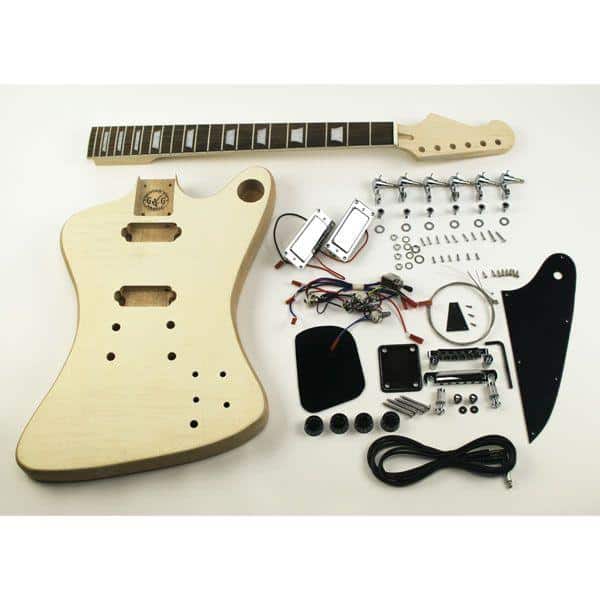
As a seasoned guitarist and avid hobbyist, I’ve assembled a multitude of guitar kits over the years, each one presenting a new learning experience. Among them all, however, I hold a special fondness for the Firebird style guitar kits. They have consistently managed to fulfill my dual passions for guitar building and playing in a truly extraordinary manner.
Imagine being able to not only play a Firebird style guitar but also having built it yourself from scratch. Intriguing, isn’t it? That is the exciting opportunity these Firebird guitar kits present. Through years of experience, I’ve concluded that Firebird guitar kits offer an unmatched combination of joy of building and playing quality. With my insights and your passion, let’s make your dream guitar real.
Firebird style guitar kits are immensely popular among music enthusiasts like you and me. Their striking design and remarkable sound, combined with the intricacy of assembly, make them a prized choice for hobbyist guitar kits. Whether you’re picking up the kit as a pastime or to learn guitar building, you’ll find the experience extremely rewarding.
The sense of satisfaction you feel when strumming a finely tuned, self-assembled Firebird style guitar is nothing less than extraordinary. But the real magic starts when you first open the kit. The blank guitar body, waiting for your personal touch, the neatly packed hardware, the raw wood of the neck and body- it’s like a call to creative exploration that is hard to resist.
Among what amplifies my fondness for Firebird guitar kits is the breadth and depth of what you can learn from assembling one. It involves painstaking precision, a lot of patience, and a keen eye for detail. Building a Firebird style guitar is no mere pastime; it is a journey that enriches your understanding of the instrument, fine-tunes your technical aptitude, and, at the same time, imbibes in you a heightened appreciation for craftsmanship.
As a bonus, these guitar kits allow for unmatched customization. Want to try out a unique color combination? Or experiment with some interesting hardware choices? It’s all possible! This freedom to make the instrument truly your own is yet another reason I’ve always been drawn to these kits.
In closing, choosing a Firebird guitar kit provides a fascinating mix of learning, craftsmanship, and satisfying creativity. It allows you to intimately familiarize yourself with the intricacies of your instrument, enhance your technical skills, and eventually, reap the satisfaction of playing an instrument you’ve built with your own hands.
So why choose a Firebird guitar kit? Simply put, it’s because there’s no other experience quite like it. It’s not just about making music; it’s about creating a unique piece of art, crafted by you, for you. And with each melodious strum, you are reminded of the journey it took to create such a personal piece of musical expression. Now that’s priceless.
The Components of a Firebird Guitar Kit
Materials and Quality
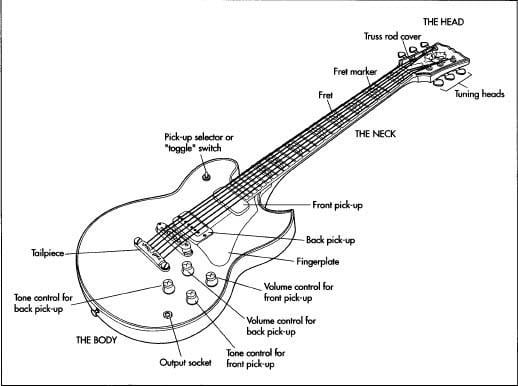
In the exploration of the Firebird guitar kit components, nothing’s more crucial than understanding the relevance of materials and their quality. In the years spent designing and researching musical instruments, it’s clear to me that a guitar’s character derives primarily from the materials used in its build.
Take, for example, the mahogany guitar body, a staples of high-quality instruments since time immemorial. Mahogany resonates at a lower frequency compared to other woods, providing a warm, rich tonal quality that lends the guitar a powerful bass and mid-range density. Given its durability and attractive grain, it’s no wonder mahogany is appreciated by professionals and hobbyists alike.
Alongside this, the ebony fretboard is iconic within the guitarist realm. A robust, dense material, ebony provides a clear, crisp tone and a sleek aesthetic. Its smooth feel under your fingertips enhances playability, helping to keep your performance fluid.
Firebird guitar kits typically offer a flame maple top in addition to the mahogany body. The hard, dense maple wood contrives a bright, sharp sound, creating a perfect contrast to the warm mahogany resonance. The intricate flame pattern on such tops introduces a naturally beautiful aesthetic sure to catch the eye.
The guitar kit’s quality is unequivocally defined by the finishing process of its materials. You want these woods to have been properly dried and machined, with exceptional attention committed to their finish. As a designer, let me assure you, the smallest imperfections can lead to adjustments in sound, playability, and overall quality of your guitar.
However, embracing a Firebird guitar kit is not just about appreciating the materials or understanding quality concerns. Hold up against its aesthetics and functionality, these high-quality materials also provide a sensorial encounter, from the tangible connection with the smooth ebony fretboard to the resonance of strummed chords from the mixed mahogany and maple body. The originality of crafting an instrument extends far beyond assembly; it truly is about shaping a unique sonic character.
As we move into discussions about the kit’s customizability, remember the importance of marrying quality materials with personal musical vision. A Firebird guitar is not an everyday guitar; it’s your guitar, complete with the character and uniqueness you impart to it. Let’s explore just how much you can make it your own in the next section.
Customizability of the Kit
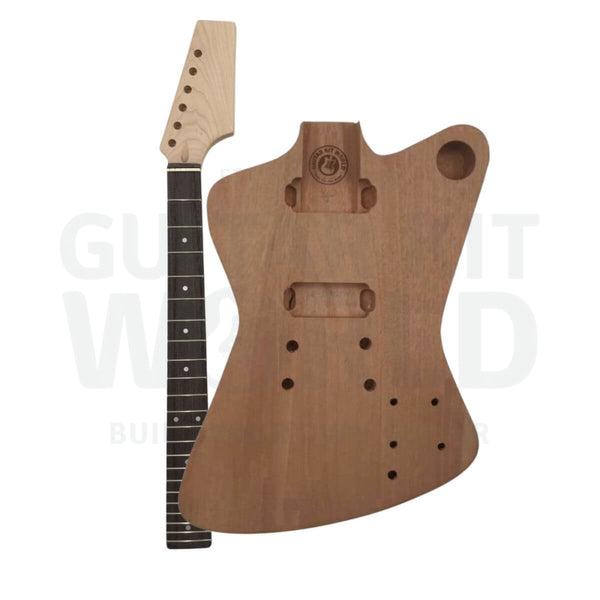
Now that we’ve explored the individual components of the Firebird guitar kit, let’s delve into the customizability aspect of this kit. Being able to modify and adapt your guitar to your preferences is a testament to the versatility of customizable guitar kits. With a Firebird replica, this is particularly significant due to its iconic, reverse body design and high-end hardware.
From the outset, a Firebird guitar kit offers you the freedom to design your own unique instrument. Whether you aspire for a vintage, high-gloss finish or prefer a contemporary satin appearance, the choice is yours. The body’s bare wood serves as a canvas for you to express your creativity. Even the neck, typically a set-in design, allows you to refine its contour and feel for a customized playing experience.
Additionally, with precisely made, customizable guitar parts available for these Firebird kits, you can find the perfect balance between the original components and those that contribute to your desired sound and functionality. If, for instance, you wish to experiment with various pickups, the guitar’s routing offers ample space for your exploration. Similarly, you have texture and shape options for your pickguard, and different grades of wiring, for an even more precise fit and personalized assembly.
The beauty of guitar kits is in their customizability. Throughout my career, I’ve benefitted from the ability to tailor every detail, from the body to the smallest screw, making each guitar a truly personalized creation. With a Firebird replica, this experience is enhanced by the high-quality components and the heritage the iconic design carries.
However, remember that customization should not compromise playability or sound quality. Maintaining a balance is crucial. Do thorough research and seek expert advice if needed before proceeding with significant modifications. After all, the goal is not only to build a Firebird electric guitar but also to create a fine instrument that resonates with your musical aesthetic and playing style.
In the next section, we’ll discuss how these components and your customized additions come together as we delve into assembling your Firebird guitar kit. This is where your personalized design transforms from a concept into a playable reality.
Assembling the Firebird Guitar Kit
Smoothing and Finishing the Body and Neck
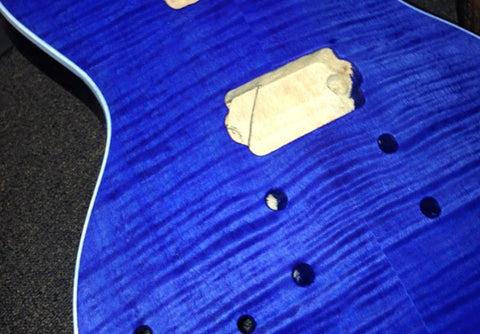
Having pieced together your Firebird Guitar kit, the next major step in our journey is perfecting the aesthetic feel and playability. This is where we gingerly step into the territory of smoothing and finishing the body and neck – a critical phase of assembling the guitar. Here, we intricately blend luthier guitar kits expertise with the artistry that elevates your instrument to a masterpiece.
As a luthier, the craftsmanship of the neck and body holds a unique appeal for me. Each stroke of my hand tools feels like I’m releasing the music trapped within the wood. Smoothing and finishing grant your guitar its distinctive look, feel, and personality. Not to mention the significant improvement it gives to the guitar’s playability. To enhance your understanding of crafting electric guitars, I’ll guide you through this pivotal process.
Starting with the neck, one of the most essential aspects of guitar neck crafting is ensuring the utmost comfort for the player’s hand. This requires meticulous scraping, sanding, and polishing to achieve an almost seamless smoothness. Each of these steps needs to be done with precision and patience, as any oversight can adversely affect how the guitar feels in your hand.
Next comes the finishing. Whether you’re opting for a translucent or opaque finish, selecting the right finish will largely depend on the wood’s grain and your personal taste. In my years of crafting guitars, I’ve found that oil finishes provide a soft, natural feel that many players appreciate. However, if you’re looking for something more vibrant and unique, consider dye-based finishes. They offer a range of colors that can make your guitar truly stand out.
Moving on the body, it’s a similar process of smoothing and finishing but on a larger scale. Remember to render special attention to the contours, the places where your body meets the guitar. A well-rounded, smoothed guitar body can significantly enhance player comfort.
In essence, perfecting the body and neck is more than mere aesthetic enhancement. It is integral to the overall playability, sound, and comfort of your Firebird guitar. The pride and satisfaction you’ll feel strumming an instrument refined by your own hands is immeasurable.
Now that we’re winding up this stage, it’s time to gear up for the next crucial one – installing the hardware. As we delve deeper into the intricate process of assembling our DIY Firebird electric guitar, look forward to seeing your vision of the perfect guitar take shape in your hands.
Installing the Hardware

Diving directly into the process of installing the hardware, allow me to utilize my engineering instincts and demonstrate how solderless guitar kit installations fuse science and art. My journey has been one of exploration and precision, skills I’m eager to share with you, as we uncover the importance of quality guitar hardware for kit assembly.
Imagine that your customizable guitar kit is in front of you, a canvas waiting to be painted. The right components, properly installed, can help your guitar sing like a bird, or roar like a firebird, as it were. From the tuners that keep your strings pitch-perfect to the pickups that capture their vibrations and convert them into ripping sound, every piece of guitar hardware has a vital role to play.
The first step in installing the hardware is to pay close attention to the bridge and tailpiece. They’re fundamental not only for maintaining string tension but also for adjusting the intonation. Misaligned, and your Firebird will sound out-of-tune, no matter how good your ear is. My approach leans on precision akin to a surgeon. Everything must be perfect.
An essential tip to remember: perfect installation is a gradual process. Do not rush to tighten the screws. Gradual adjustments ensure the strings seat well and also prevent damage to the finish.
Next, we address the tuners. Their primary function is to adjust string tension and thus regulate the pitch. Be mindful of placing them correctly. A wrongly-positioned tuner can affect your playing experience. Here again, a slow and steady approach works best.
When installing the pickups, always invest in solderless installations. They’re beginner-friendly, easy to repair, and, best of all, offer amazing flexibility when swapping parts. Adjustable tones, courtesy of your solderless guitar kit, can produce an array of sound flavors, from clear, high-definition tones to dark, brooding notes.
In this journey of assembling a Firebird guitar kit, the installation of hardware is not simply a mechanical process. It’s a transformative phase, where disconnected elements start to unite and form something beautiful and harmonious. It’s the genesis of a personalized sound, a reflection of your character.
By the end of this stage, the Firebird will start to feel less like a project and more like a musical instrument. Now that the hardware is in place, we can move onto the next exciting step – setting up and testing your assemblage of art and craft. To reach that pro-level precision and hit the right chords, follow us as we transition to the next critical phase in building your custom Firebird.
Setting Up and Testing Your Firebird Guitar

Right, we’ve reached the pivotal point on the journey of our home guitar building project – the setup and testing of our beloved Firebird electric guitar. As someone who’s taken many premier musical instruments through their paces, trust me when I say it’s one of the most gratifying stages of the entire process. This is the moment where your hands-on craftsmanship takes form and truly comes to life.
Having come this far with the Firebird bass kit, you’ve shown brilliance and patience, carefully assembling every piece, smoothing and finishing the body and neck, and installing the hardware. Now let’s channel our intent into setting up and tuning this beautiful instrument so it radiates melodies as soulful as the Firebird it’s named after.
Setup and testing – the final stages before your crafted beauty sings out loud. Ready to hear the melody?
Let’s kick start it with some crucial guitar kit setup tips. Primarily, ensure your guitar’s neck is straight. If there’s excessive bow in either direction, adjust the truss rod. Remember – the righty tighty, lefty loosey rule. A clockwise turn increases tension, counteracting bowing, while a counter-clockwise turn reduces tension to alleviate back bow.
Next, adjust the action by raising or lowering the bridge. High action often translates to intonation problems and difficult playability. Low action, although easy on your fingers, can cause fret buzz. Find your sweet spot, with the strings close enough for comfortable play but without hitting the frets to create unwanted noise.
Pickup height is also crucial. Too close to the strings, and you’ll get a magnetic pull interfering with vibrations. Too far, and your sound will lack volume and punch. It may take some tweaking, but find a balance where the string vibration isn’t excessively affected, yet the pickups can still effectively amplify.
The last step in our setup is tuning. An out of tune guitar will sound off no matter how well it’s built! Using a digital tuner can help quickly get the guitar in tune and also easily sort any intonation issues. Shy of a tuner, a well-trained musical ear may suffice, although it’s not the most precise method.
Finally, it’s playtime. Testing is not merely about identifying issues; it’s your virgin encounter with the unique sound only your guitar can produce. As a musician who has built multiple electric guitars, I still vividly remember the sound of the first chord I strummed on each of my creations. It’s a memory as reverberating as the note itself.
This chapter takes me back to my roots in engineering: testing and perfecting. My experience gained from setup and playing of different guitars will ensure your Firebird guitar performs beautifully. The Firebird is more than just a beautifully constructed instrument; it’s a melodic companion begging to entertain you with a rich symphony of sound, awaiting the skilled touch of the craftsman who brought it to life.
After these steps, if you find any inconsistencies or if the output is not as expected, don’t hesitate in going back to adjust the setup. DIY electric guitar building is not about swift completion but gradual, calibrated strides towards musical perfection. Remember, the goal here is not to just build a guitar but to craft an extension of yourself.
Now secure your strap; it’s time for your Firebird to take flight and fill the air with music that’s truly your creation.
Reviews and Recommendations
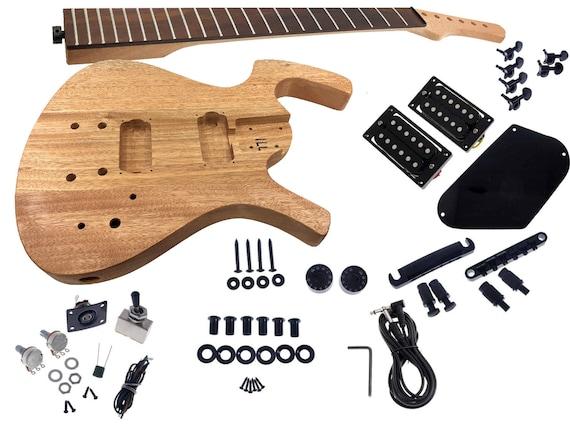
In my journey as a seasoned contributor to the American Lutherie journal, I’ve had the pleasure of exploring numerous guitar kits. I can confidently say that the Firebird guitar kit has consistently stood out to me, mainly for its unique aesthetic appeal, customizable nature, and excellent playability. As it turns out, my readers and the wider guitar-building community share this sentiment, with positive guitar kit reviews all echoing the same allure of the Firebird.
Keen to know some of the best Firebird guitar kits on the market? Let’s explore together.
After familiarizing myself with a multitude of models, I have a few personal favorites. My top recommendation is the DIY Firebird Electric Guitar Kit from StewMac. It never fails to amaze me with its quality components – a mahogany body, a slim taper maple neck, and a rosette of premium hardware options. It’s such a delight to build, no matter if you’re a beginner hobbyist or an accomplished luthier. Another remarkable choice is the Saga FB-1 Firebird Style Guitar Kit. With its bold design and the quality of the components provided, this kit appeals to those yearning for a more traditional tonality in their finished instrument.
Another community favorite is the LifeMods Firebird kit. The tone wood quality is excellent, and it’s a great canvas for your creativity. It’s stripped-down, so you get to choose your own pickups and fittings. It’s perfect for those who enjoy delving deep into granular customization.
While the Firebird guitar kit offers a great deal of diversity, there is one key aspect that unites them all – the satisfaction that comes with crafting your own personalized instrument. As I went through the process myself and dived into corresponding reviews, it became increasingly clear that building a Firebird is not just about crafting an instrument – it’s about crafting your own musical story.
If you’re ever in doubt, remember that the guitar kit reviews are an excellent resource. Not only do they provide insights into what to expect, but they can also inspire and guide you through the process. As a professional luthier, I’ve learned from each review and integrated what I’ve learned into my craft.
I hope my personal insights are helpful in making your choice and embark on your journey of assembling a Firebird guitar kit. Remember, the journey of building your guitar is an intimate musical experience, and each kit invites a unique tale waiting to be unfurled under your fingertips. It’s not only the final instrument that matters, it’s the process of bringing your unique vision to life that truly characterizes the Firebird experience.
As we move forward in this guide, we’ll address some of the frequently asked questions about the Firebird guitar kit, offering you comprehensive insights and equipping you with everything you need to know before you confirm your purchase. So let’s dive even deeper into this rich world of guitar-building.
FAQs
What is a DIY Firebird Electric Guitar Kit?
What parts are included in a DIY Firebird Electric Guitar Kit?
How long does it take to assemble a DIY Firebird Electric Guitar Kit?
Why should I consider building a DIY Firebird Electric Guitar?
Conclusion
As we conclude this comprehensive journey, I feel compelled to remind you of the profound personal potential contained within a DIY electric guitar kit. Your interaction with a Firebird guitar kit isn’t just about fitting components or crafting a musical instrument, it’s about channeling your creativity, ambition, and musical persona into a work of art that resonates uniquely with you.
Have you ever dreamt of creating something unique, something that reflects your persona? That’s the magic of building your own Firebird guitar from a DIY kit. This is where we transform a desire into reality, where we mould our love for music into a tangible form.
Through this guide, we’ve travelled from understanding why a Firebird guitar kit is worth your effort, dissected its core components, and explored the customizability of the kit. Together, we’ve assessed the materials and quality, navigated the process of assembly, and engaged in essential steps like smoothing the body and neck, installing the hardware, and setting up the guitar. We’ve analysed reviews and tackled several FAQs to provide you with a comprehensive understanding to undertake this beautiful project.
The essence of my knowledge and experiences captured here only become meaningful when they aid you in your journey. Lutherie has been my life’s biggest teacher and if there’s one thing it has instilled in me it’s that every guitar has a story. As we part ways here, remember that I am here to help you write yours with this DIY Firebird guitar kit. Here’s to the beginning of another musical adventure!
Now, with the insights and understanding you’ve gained, the moment has arrived for you to unleash your creativity and passion. It’s time to make that dream a reality and create a masterpiece that not only produces beautiful music but also reflects your individuality. Intricate, personal, rewarding – your adventure in the symphony of lutherie awaits. Start building your Firebird guitar now!
